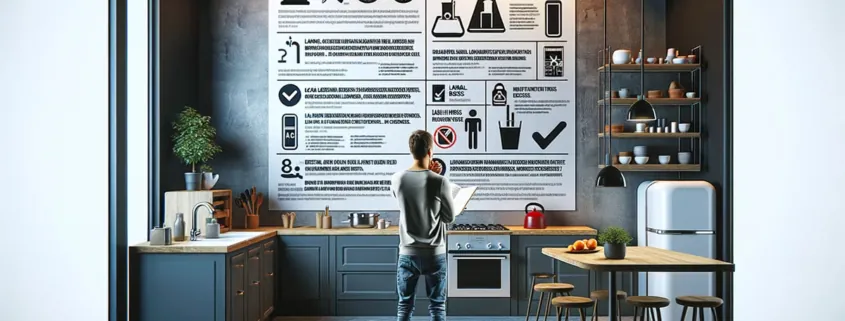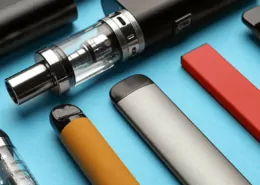Is Vaping Allowed In The Kitchen? What To Know
As vaping surges in popularity, many wonder about the appropriate places to use e-cigarettes. With millions of adults and youth now vaping regularly, it’s important to understand the regulations and risks associated with using these devices in various settings – including the kitchen.
The Legality of Kitchen Vaping
Whether you can legally vape in the kitchen depends on several factors, including:
- State and Local Laws: Some states and municipalities have banned vaping in all enclosed public spaces, which can include restaurant kitchens. Always check your local regulations before using e-cigarettes indoors.
- Workplace Policies: Even if your state allows public vaping, your employer may prohibit e-cigarette use on the job. Foodservice businesses often restrict kitchen vaping to avoid contamination and health risks.
- Building Rules: If you live in an apartment or condo, your lease or HOA agreement may specify no-vaping policies that extend to personal kitchens. Violating these rules could lead to fines or eviction.
As of 2023, at least ten states have implemented comprehensive indoor vaping bans:
- California
- Delaware
- Hawaii
- Maine
- New Jersey
- North Dakota
- Oregon
- Utah
- Vermont
- Washington
Many other states have partial restrictions on vaping in specific venues like schools, hospitals, and government buildings. But the absence of a state-level ban doesn’t automatically mean kitchen vaping is allowed. Local ordinances in cities and counties may impose stricter rules than state law requires.
The bottom line? Always err on the side of caution and assume vaping is prohibited in any professional kitchen setting. For personal kitchens, check your lease and local laws before using e-cigarettes indoors.
Health Risks of Vaping Around Food
Even if kitchen vaping is legally permissible where you live, there are compelling safety reasons to avoid the practice:
1. Food Contamination
The vapor produced by e-cigarettes contains a complex mixture of chemicals, including propylene glycol, vegetable glycerin, flavorings, and oftentimes nicotine. When exhaled near food, these substances can settle on surfaces and potentially be ingested by others.
Studies have detected the presence of nicotine and other vape chemicals in dust and on surfaces in homes where e-cigarettes were used. While the long-term health effects of this “thirdhand exposure” are still being researched, it’s best to avoid any risk of contaminating food with vape residue.
2. Indoor Air Pollution
Vaping may not produce the same pungent odor as traditional smoking, but it can still compromise indoor air quality. The ultrafine particles and chemicals in e-cigarette aerosol can linger in the air and be inhaled by others in the room.
This secondhand exposure is especially concerning in poorly ventilated spaces like small kitchens. Children, pregnant individuals, and people with respiratory conditions may be particularly vulnerable to the irritants in secondhand vape.
3. Fire and Burn Hazards
Kitchens are full of heat sources and flammable materials, making them particularly risky places to use battery-powered devices like vapes. E-cigarettes have been known to explode or catch fire, especially when left charging unattended.
In a busy cooking environment, a vape battery malfunction could easily ignite grease, paper products, or clothing. Severe burns and property damage can result from vape fires in the kitchen.
4. Flavor Interactions
Vape e-liquids come in a dizzying array of flavors, from fruity and candy-like to savory and dessert-inspired. While these flavors may taste great to the user, they don’t necessarily complement the aroma of food being prepared nearby.
Pungent vape clouds could alter the perceived taste of certain dishes in unappetizing ways. Conversely, strong cooking smells might make the vape experience less enjoyable. It’s best to keep these sensory experiences separate.

ECIGATOR
Ecigator is one of the well-known vape brands spun off from FM Technology Co., Ltd, it’s an ISO-certified disposable vape manufacturer for OEMs, ODMs, and OBM since 2010. The founder team comes from top firms with more than 10 years of experience in the vaping industry and has devoted thousands of hours to providing users with a better and better experience.
Responsible Vaping Practices
If you do choose to vape, there are steps you can take to minimize risks and be a considerate e-cigarette user:
- Follow All Laws and Policies: Respect any no-vaping rules set by your employer, landlord, or local government. Don’t assume it’s okay to vape just because you don’t see a sign posted.
- Use Designated Areas: Many businesses and public spaces have designated outdoor smoking and vaping areas. Use these whenever possible to avoid exposing others to secondhand aerosol.
- Keep Vapes Away from Kids: Store your vaping devices and e-liquids securely out of reach of children. Nicotine poisoning can occur if kids accidentally ingest e-juice or get it on their skin.
- Don’t Stealth Vape: Avoid the temptation to take discreet puffs in places where vaping is prohibited, like restaurant bathrooms or break rooms. Getting caught could lead to fines or job termination.
- Be Mindful of Others: Even if vaping is allowed in a particular space, be considerate of those around you. Not everyone enjoys the smell of vape flavor or wants to inhale your secondhand aerosol.
- Invest in Quality Devices: Cheap, counterfeit vapes are more likely to malfunction and pose safety hazards. Buy your vaping equipment from reputable manufacturers with strong quality control standards.
By following these guidelines, you can enjoy vaping while minimizing potential harm to yourself and others.
Alternative Vaping Locations
If kitchen vaping is off-limits, there are other places where you may be able to use your e-cigarette legally and safely:
- Private Residences: Vaping is generally allowed inside homes, as long as it doesn’t violate any lease agreements or condo rules. Just be mindful of secondhand exposure to family members and pets.
- Outdoor Spaces: Many cities allow vaping in outdoor public areas like parks and sidewalks. However, some places like beaches and sports arenas may have specific vape-free zones.
- Vape Shops and Lounges: Specialty vape stores often have sampling bars or lounges where customers can try out different e-juice flavors and devices. These establishments cater specifically to vapers and can be a great place to connect with fellow enthusiasts.
- Designated Smoking Areas: If a restaurant or bar has an outdoor smoking section, it’s usually okay to vape there as well. Just be sure to ask the staff first and follow any posted rules.
Remember, just because vaping is allowed somewhere doesn’t mean it’s always appropriate. Use your best judgment and be respectful of those around you to ensure a positive vaping experience for all.
Conclusion
The popularity of vaping has raised important questions about where and how e-cigarettes should be used responsibly. When it comes to kitchen vaping, the answer is often no – both for legal and safety reasons.
Many states and municipalities have banned vaping in enclosed workplaces, which typically includes restaurant and commercial kitchens. Even personal kitchens may be subject to no-vaping rules set by landlords or condo associations.
Beyond the legal considerations, there are compelling health and safety reasons to avoid vaping around food. The chemicals in e-cigarette aerosol can settle on surfaces and contaminate meals, while secondhand exposure can compromise indoor air quality. The risk of vape battery fires is also heightened in busy cooking environments.
If you do choose to vape, it’s important to do so responsibly by following all applicable laws and policies, using designated vaping areas, and being considerate of those around you. By taking these precautions, you can enjoy the benefits of vaping while minimizing potential harm to yourself and others.
Ultimately, the decision to vape in the kitchen or any other space is a personal one that requires careful consideration of the risks and regulations involved. Stay informed, use your best judgment, and always prioritize safety to ensure a positive vaping experience for all.
- Is Vaping and Driving Illegal in Vermont? (2025 Guide) - July 18, 2025
- Vaping Laws in Vermont : A Comprehensive Guide for 2025 - July 18, 2025
- Malaysian Sarawak Considers Banning Vape Product Sales - July 18, 2025









